Furuno USA 9ZWRTR101 Transceiver for Radar model FAR-1518/1528 User Manual
Furuno USA Inc Transceiver for Radar model FAR-1518/1528
Contents
- 1. Installation Manual Part 3
- 2. Installation Manual Part 1
- 3. Installation Manual Part 2
- 4. Installation Manual Part 4
- 5. Installation Manual Part 5
- 6. Installation Manual Part 6
- 7. User Manual Part 1
- 8. User Manual Part 2
- 9. User Manual Part 3
- 10. User Manual Part 4
- 11. User Manual Part 5
- 12. User Manual Part 6
Installation Manual Part 1

www.furuno.com
A
ll brand and product names are trademarks, registered trademarks or service marks of their respective holders.
Installation Manual
MARINE RADAR
Model FAR-1513/1513-BB/1523/1523-BB/
FAR-1518/1518-BB/1528/1528-BB
SAFETY INSTRUCTIONS ................................................................................................ i
SYSTEM CONFIGURATION .......................................................................................... iii
EQUIPMENT LIST ........................................................................................................... v
1. INSTALLATION.......................................................................................................1-1
1.1 Before Beginning the Installation... ................................................................................... 1-1
1.2 Antenna Unit Installation Considerations .......................................................................... 1-2
1.3 How to Install the Antenna Unit for FAR-1518, FAR-1528................................................ 1-3
1.4 How to Install the Antenna Unit for FAR-1513, FAR-1523................................................ 1-6
1.5 Processor Unit ................................................................................................................ 1-10
1.6 Display Unit..................................................................................................................... 1-11
1.7 Control Unit ..................................................................................................................... 1-11
1.8 Trackball Control Unit (option) ........................................................................................ 1-12
2. WIRING....................................................................................................................2-1
2.1 Wiring Outline ................................................................................................................... 2-1
2.2 How to Connect the Signal Cable for FAR-1518, FAR-1528 ............................................ 2-2
2.3 How to Connect the Signal Cable for FAR-1513, FAR-1523 ............................................ 2-6
2.4 Processor Unit ................................................................................................................ 2-11
2.5 Trackball Control Unit ..................................................................................................... 2-19
2.6 VDR Connection ............................................................................................................. 2-20
3. ADJUSTMENTS ......................................................................................................3-1
3.1 How to Open the Radar Installation Menu ........................................................................ 3-1
3.2 How to Use the Menu ....................................................................................................... 3-2
3.3 How to Initialize Tuning.....................................................................................................3-2
3.4 How to Align the Heading ................................................................................................. 3-3
3.5 How to Adjust Sweep Timing ............................................................................................ 3-4
3.6 How to Suppress Main Bang ............................................................................................ 3-4
3.7 RADAR INSTALLATION Menu......................................................................................... 3-5
4. INPUT/OUTPUT DATA............................................................................................4-1
4.1 Processor Unit .................................................................................................................. 4-1
4.2 IEC 61162 Sentences ....................................................................................................... 4-2
APPENDIX 1 JIS CABLE GUIDE .............................................................................AP-1
APPENDIX 2 DIGITAL INTERFACE ........................................................................AP-2
PACKING LISTS ......................................................................................................... A-1
OUTLINE DRAWINGS ................................................................................................ D-1
INTERCONNECTION DIAGRAM ................................................................................ S-1

The paper used in this manual
is elemental chlorine free.
・FURUNO Authorized Distributor/Dealer
9-52 Ashihara-cho,
Nishinomiya, 662-8580, JAPAN
A
:
0000
Printed in Japan
All rights reserved.
Z7
:
JUL
.
30, 2015
Pub. No.
IME-36380-Z7
(
DAMI
)
FAR-15X3/15X8/BB
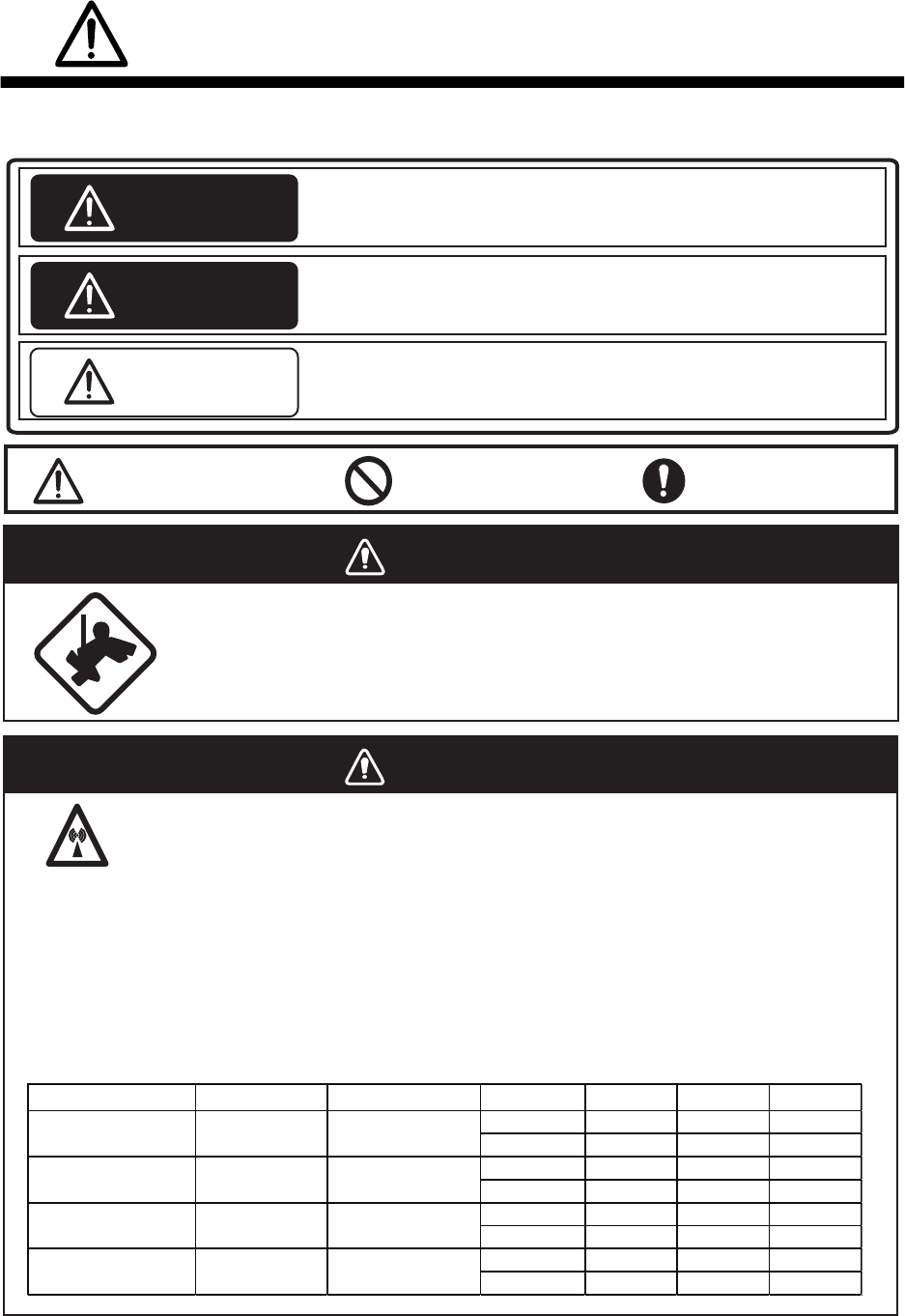
i
SAFETY INSTRUCTIONS
Mandatory Action
Prohibitive Action
WARNING
Indicates a potentially hazardous situation which, if not avoided,
could result in death or serious injury.
CAUTION
Indicates a potentially hazardous situation which, if not avoided,
can result in minor or moderate injury.
Warning, Caution
WARNING
Radio Frequency Radiation Hazard
DANGER
Indicates a potentially hazardous situation which, if not avoided,
will result in death or serious injury.
Wear a safety belt and hard hat when working on the antenna unit.
Serious injury or death can result if someone falls from the radar antenna
mast.
DANGER
The radar antenna emits electromagnetic radio frequency (RF) energy which can be harmful,
particularly to your eyes. Never look directly into the antenna aperture from a close distance while the
radar is in operation or expose yourself to the transmitting antenna at a close distance. Distances at
which RF radiation level of 100 W/m2, 50 W/m2 and 10 W/m2 are given in the table below.
If the antenna unit is installed at a close distance in front of the wheel house, your administration may
require halt of transmission within a certain sector of antenna revolution. See the installation manual
for how to manage blind sectors.
The installer of the equipment must read the applicable safety instructions before attempting to install
the equipment.
Radar model Transceiver Magnetron Antenna
100W/m
2
50W/m
2
10W/m
2
XN12A N/A 2.1 m
XN13A N/A 1.9 m
XN12A 0.6 m 4.6 m
XN13A 0.4 m 3.1 m
XN12AF 0.3 m 0.7 m 4.1 m
XN20AF 0.2 m 0.5 m 3.1 m
XN20AF 0.6 m 1.2 m 6.1 m
XN24AF 0.3 m 0.8 m 4.0 m
MAF1565N
M1458F
MAF1615B
MG5436
FAR-1513
FAR-1523
FAR-1518
FAR-1528
RTR-086A
RTR-087A
RTR-100
RTR-101
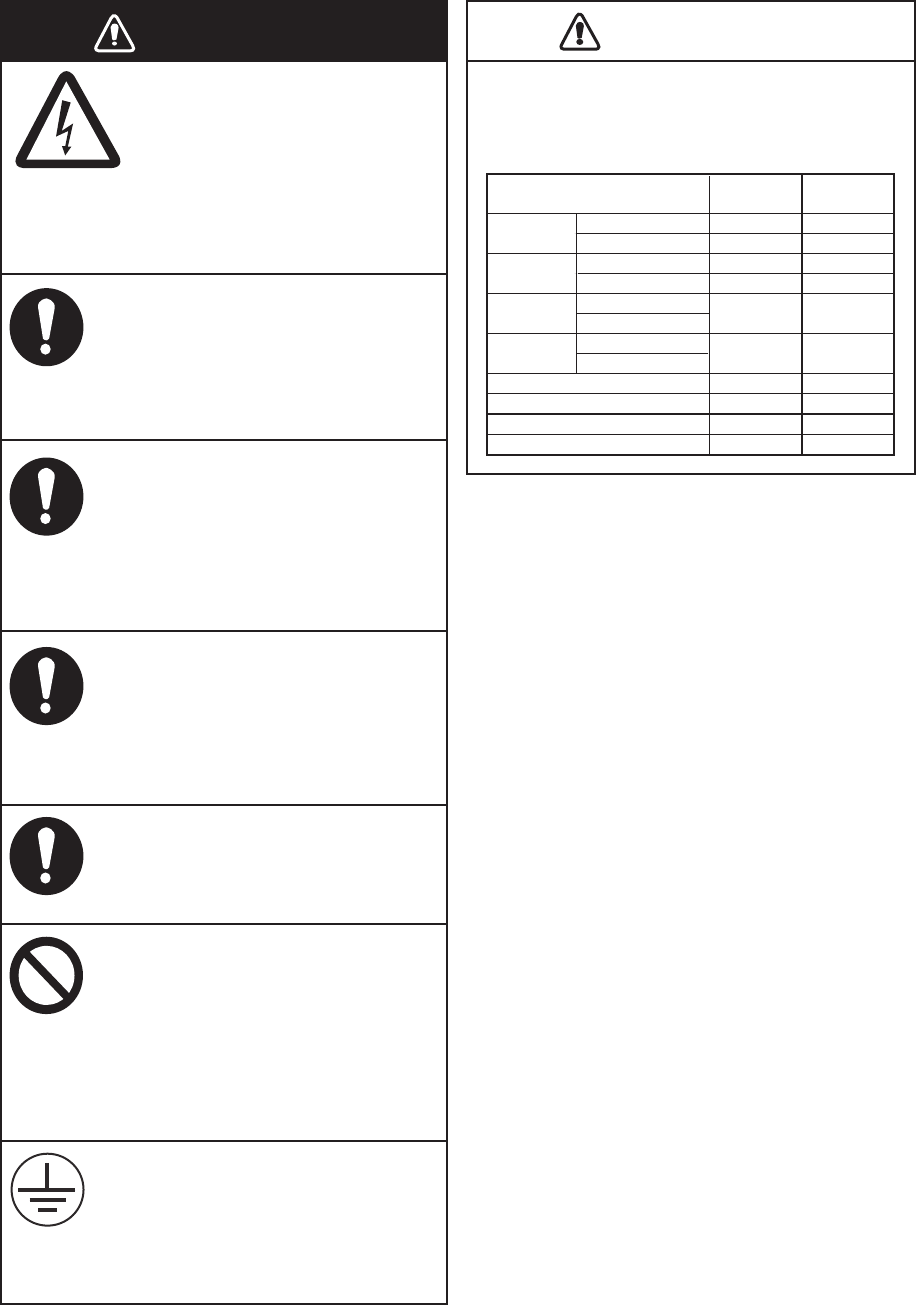
SAFETY INSTRUCTIONS
ii
CAUTION
Observe the following compass safe
distances to prevent interference to a
magnetic compass:
Note: For more information, please refer to IMO
SN/Circ.271 “Guidelines for the installa-
tion of shipborne radar equipment.”
Do not open the equipment
unless totally familiar with
electrical circuits and
service manual.
Only qualified personnel
are allowed to work inside the
equipment.
WARNING
ELECTRICAL
SHOCK
HAZARD
Construct a suitable service
platform from which to install the
antenna unit.
Serious injury or death can result if
someone falls from the radar antenna
mast.
Turn off the power at the mains
switchboard before beginning the
installation.
Fire, electrical shock or serious injury
can result if the power is left on or is
applied while the equipment is being
installed.
Be sure that the power supply is
compatible with the voltage rating
of the equipment.
Connection of an incorrect power
supply can cause fire or damage the
equipment.
Use only the specified power
cable.
Fire or damage to the equipment can
result if a different cable is used.
Do not install the processor unit,
marine display or a control unit in
a dusty environment, or one where
the units may get wet from rain or
water splash.
Dust or water in the units can result in
fire, electrical shock, or damage to
the equipment.
Attach protective earth for
processor unit securely to the
ship's body.
The protective earth (grounding) is
required for the AC power supply to
prevent electrical shock.
Unit Standard
compass
Steering
compass
Antenna Unit
for FAR-1513
Antenna Unit
for FAR-1523
Antenna Unit
for FAR-1518
RSB-0070 1.00 m 0.60 m
RSB-0073 1.10 m 0.70 m
RSB-0070 1.85 m 1.25 m
RSB-0073 1.80 m 1.15 m
RSB-120
RSB-121
RSB-120
RSB-121
Processor Unit (RPU-024) 2.60 m 1.70 m
Control Unit (RCU-028) 0.90 m 0.60 m
Display Unit (MU-150HD(-CV15)) 0.65 m 0.45 m
Trackball Control Unit (RCU-030) 0.50 m 0.30 m
Antenna Unit
for FAR-1528
1.55 m 1.00 m
2.05 m 1.30 m
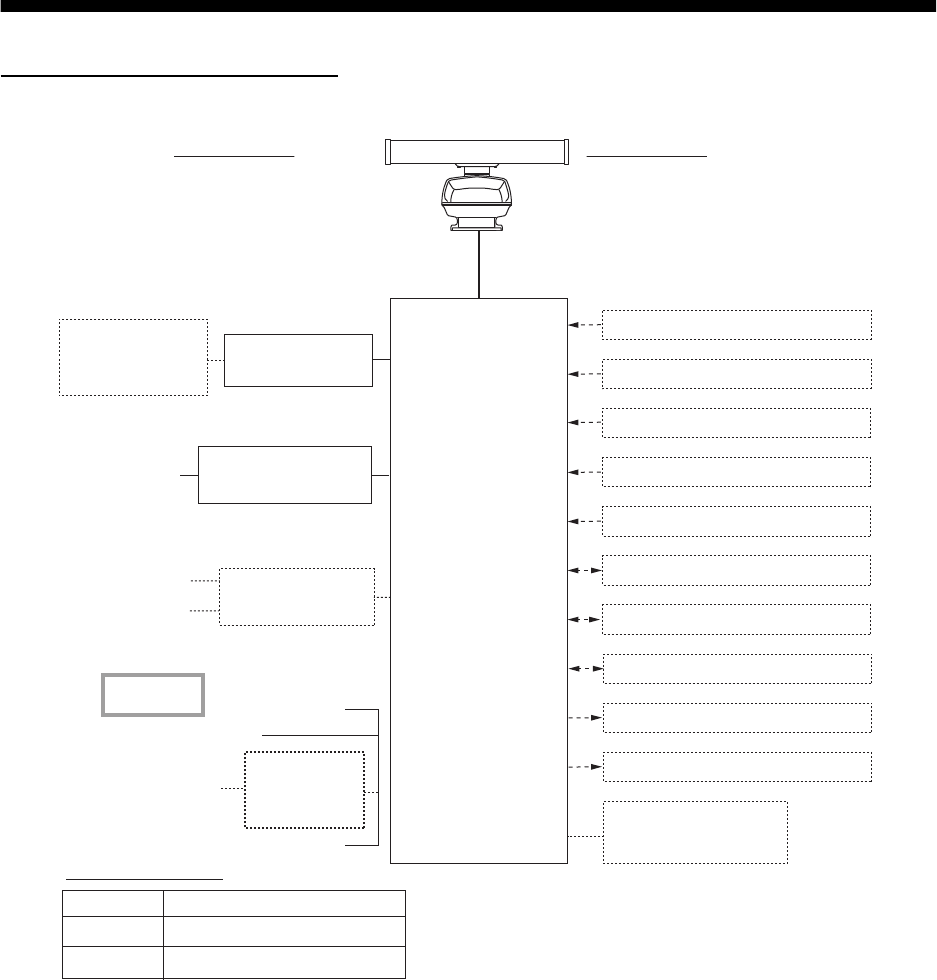
iii
SYSTEM CONFIGURATION
FAR-1513(-BB), FAR-1523(-BB)
ANTENNA UNIT
FAR-1513(-BB)
XN12A-RSB-0070-086A
XN12A-RSB-0073-086A
XN13A-RSB-0070-086A
XN13A-RSB-0073-086A
FAR-1523(-BB)
XN12A-RSB-0070-087A
XN12A-RSB-0073-087A
XN13A-RSB-0070-087A
XN13A-RSB-0073-087A
Equipment category
PROCESSOR UNIT
RPU-024
Unit Category
Antenna Exposed to the weather
Other units Protected from the weather
CONTROL UNIT
RCU-028
TRACKBALL
CONTROL UNIT
RCU-030
12-24 VDC DISPLAY UNIT
MU-150HD(-CV15)*2
SWITCHING HUB
HUB-100
100-230 VAC
1ø, 50/60 Hz
Interswitch
Gyrocompass *1, AD-10 format
Gyrocompass *
1
, IEC61162 format
AIS Transponder
EPFS (GPS)
SDME (Speed log)
AMS, IEC61162 format
ECDIS
AMS (Contact)*3
Sub Display 1
Sub Display 2
VDR
or
Analog RGB Monitor
*1: The gyrocompass must also have an update rate that is adequate for the ship’s rate of turn.
The update rate must be better than 40 Hz (HSC) or 20 Hz (conventional vessel).
*2:This monitor have been approved by the IMO, MU-150HD(-CV15) for CAT 3. If a different monitor is
to be used on IMO vessels, its effective diameter must meet the applicable Category requirements
(CAT 3: Effective diameter 180 mm or higher). For installation, operation and viewing distance of
other monitors, see their respective manuals. For BB types, a monitor is to be prepared by the user.
*3: Characteristics of contact output for AMS (Alert Management System):
• (Load current) 250 mA
• (Polarity) Normally Open: 2 ports, Normally Close: 2 ports
100/110/115
200/220/230
1ø, 50/60 Hz
DC Spec.
24 VDC
Rectifier
RU-1746-B
RU-3424
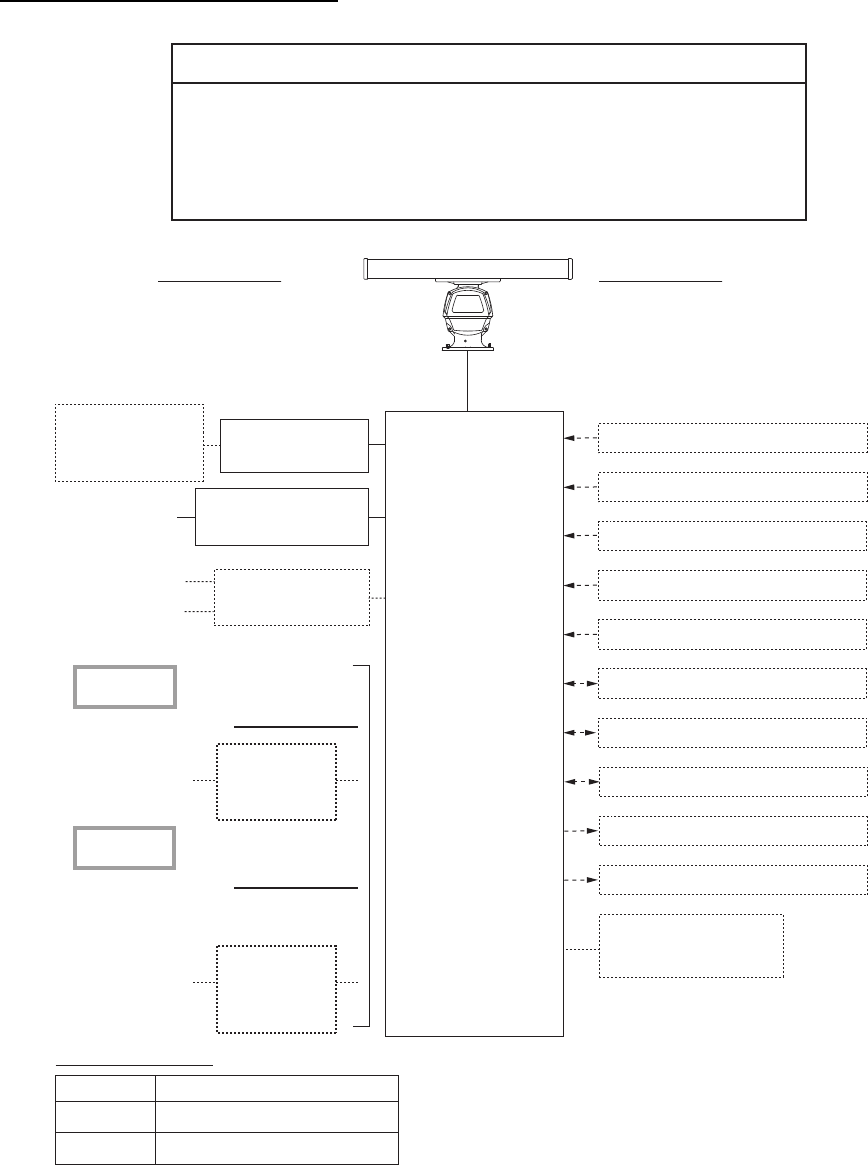
SYSTEM CONFIGURATION
iv
FAR-1518(-BB), FAR-1528(-BB)
Equipment category
ANTENNA UNIT
100/110/115
200/220/230
1ø, 50/60 Hz
PROCESSOR UNIT
RPU-024
12-24 VDC
CONTROL UNIT
RCU-028
TRACKBALL
CONTROL UNIT
RCU-030
DISPLAY UNIT
MU-150HD(-CV15)*2
SWITCHING HUB
HUB-100
100-230 VAC
1ø, 50/60 Hz
Interswitch
DC Spec.
24 VDC
Rectifier
RU-1746-B
RU-3424
440 VAC
1ø, 50/60 Hz
AC Spec.
Stepdown
Transformer
Unit
RU-1803
100/110/115
200/220/230
1ø, 50/60 Hz
Gyrocompass *1, AD-10 format
Gyrocompass *
1
, IEC61162 format
AIS Transponder
EPFS (GPS)
SDME (Speed log)
AMS, IEC61162 format
ECDIS
AMS (Contact)*3
Sub Display 1
Sub Display 2
FAR-1518(-BB)
XN12AF-RSB-120-100
XN12AF-RSB-121-100
XN20AF-RSB-120-100
XN20AF-RSB-121-100
FAR-1528(-BB)
XN20AF-RSB-120-101
XN20AF-RSB-121-101
XN24AF-RSB-120-101
XN24AF-RSB-121-101
The radar(s) must be interconnected to the following type approved sensors:
• Gyrocompass meeting requirements of the IMO resolution A.424(XI).
• EPFS meeting the requirements of the IMO resolution MSC.112(73).
• SDME meeting the requirements of the IMO resolution MSC.86(72).
The radar may be interconnected via HUB-100 to other FURUNO processing
units having approved LAN ports.
NOTICE FOR FAR-1518(-BB)/FAR-1528(-BB)
VDR
or
Analog RBG Monitor
*1: The gyrocompass must also have an update rate that is adequate for the ship’s rate of turn.
The update rate must be better than 40 Hz (HSC) or 20 Hz (conventional vessel).
*2:This monitor have been approved by the IMO, MU-150HD(-CV15) for CAT 3. If a different monitor is
to be used on IMO vessels, its effective diameter must meet the applicable Category requirements
(CAT 3: Effective diameter 180 mm or higher). For installation, operation and viewing distance of
other monitors, see their respective manuals. For BB types, a monitor is to be prepared by the user.
*3: Characteristics of contact output for AMS (Alert Management System):
• (Load current) 250 mA
• (Polarity) Normally Open: 2 ports, Normally Close: 2 ports
Unit Category
Antenna Exposed to the weather
Other units Protected from the weather
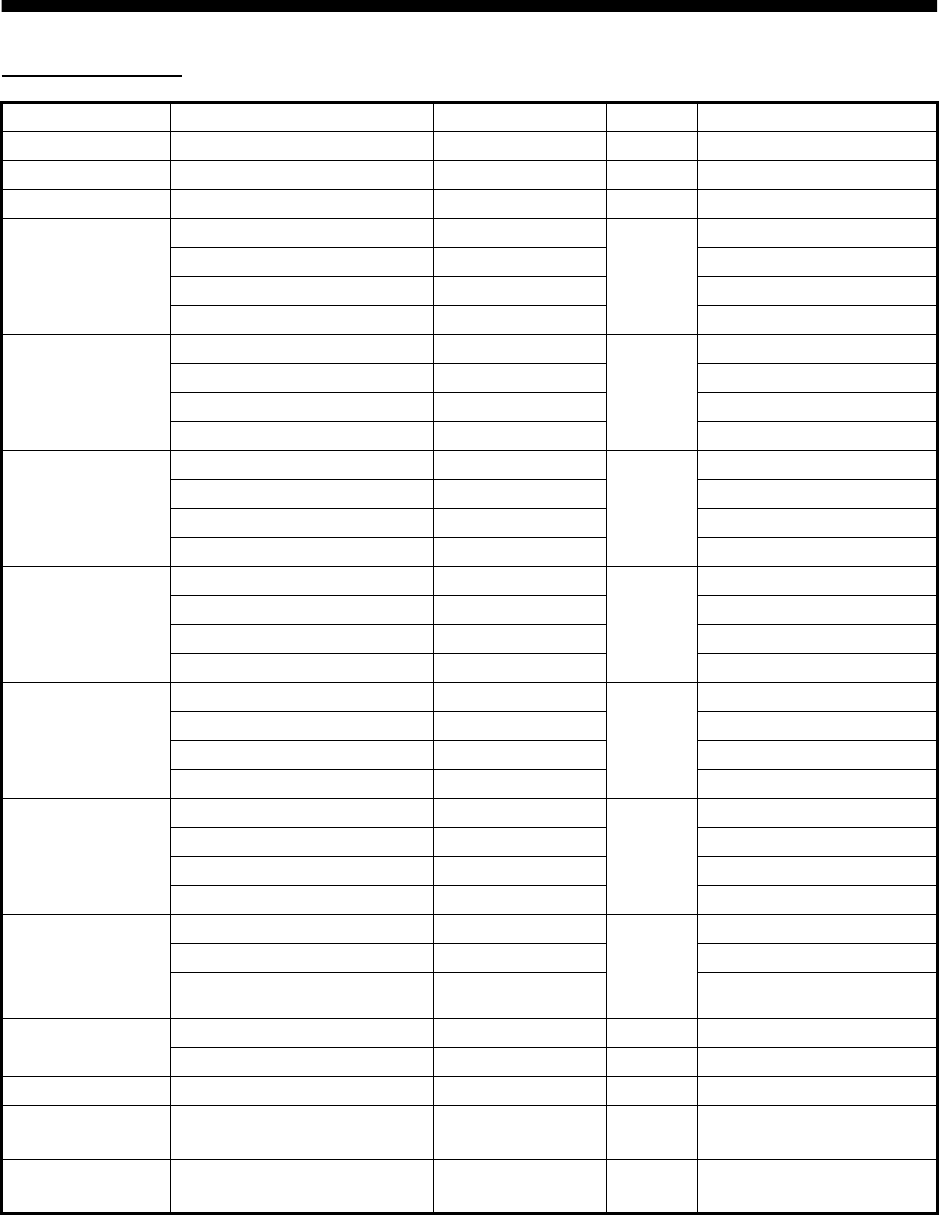
v
EQUIPMENT LIST
Standard supply
Name Type Code No. Qty Remarks
Processor Unit RPU-024 - 1
Control Unit RCU-028 - 1
Display Unit MU-150HD-CV15 - 1
Antenna Unit
(FAR-1513)
XN12A-RSB-0070-086A -
Select
one
24 rpm, 1200 mm
XN12A-RSB-0073-086A - 48 rpm, 1200 mm
XN13A-RSB-0070-086A - 24 rpm, 1800 mm
XN13A-RSB-0073-086A - 48 rpm, 1800 mm
Antenna Unit
(FAR-1523)
XN12A-RSB-0070-087A -
Select
one
24 rpm, 1200 mm
XN12A-RSB-0073-087A - 48 rpm, 1200 mm
XN13A-RSB-0070-087A - 24 rpm, 1800 mm
XN13A-RSB-0073-087A - 48 rpm, 1800 mm
Antenna Unit
FAR-1518)
XN12AF-RSB-120-100 -
Select
one
26 rpm, 1200 mm
XN12AF-RSB-121-100 - 48 rpm, 1200 mm
XN20AF-RSB-120-100 - 26 rpm, 2000 mm
XN20AF-RSB-121-100 - 48 rpm, 2000 mm
Antenna Unit
(FAR-1528)
XN20AF-RSB-120-101 -
Select
one
26 rpm, 2000 mm
XN20AF-RSB-121-101 - 48 rpm, 2000 mm
XN24AF-RSB-120-101 - 26 rpm, 2400 mm
XN24AF-RSB-121-101 - 48 rpm, 2400 mm
Installation
Materials
(FAR-1513)
CP03-36700 001-421-520
Select
one
10 m signal cable
CP03-36710 001-421-530 15 m signal cable
CP03-30720 001-421-540 20 m signal cable
CP03-36730 001-421-550 30 m signal cable
Installation
Materials
(FAR-1523)
CP03-36800 001-423-400
Select
one
10 m signal cable
CP03-36810 001-423-410 15 m signal cable
CP03-36820 001-423-420 20 m signal cable
CP03-36830 001-423-430 30 m signal cable
Installation
Materials
(FAR-1518,
FAR-1528)
CP03-36900 001-423-440
Select
one
15 m signal cable
CP03-36910 001-423-450 20 m signal cable
CP03-36920 001-423-460 30 m signal cable
Installation
Materials
CP03-36501 001-419-860 1
CP03-36601 001-419-600 1
Cable Assy. DVI-D/D S-LINK 5M 001-132-960-10 1
Spare Parts SP03-18001 001-419-820 1 Fuses (2), for DC power
processor unit
Spare Parts SP03-18002 001-419-830 1 Fuses (2), for AC power
processor unit
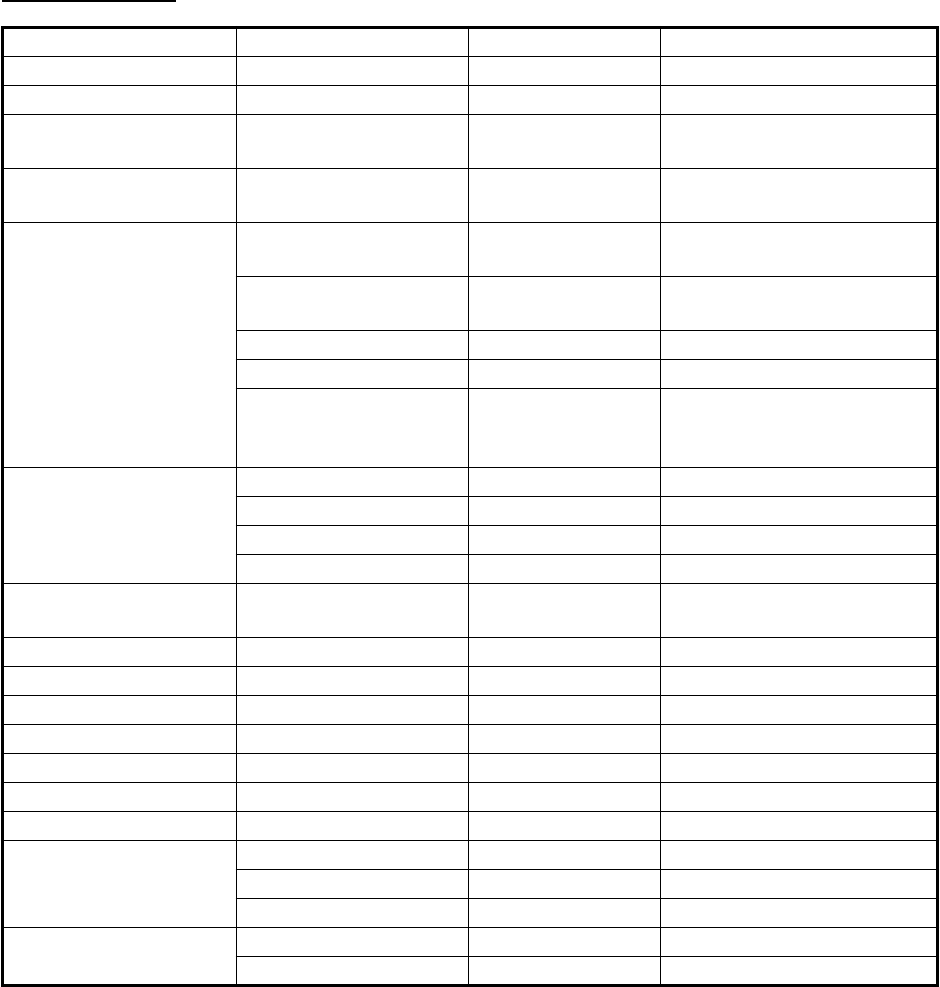
EQUIPMENT LIST
vi
Optional supply
Name Type Code No. Remarks
Trackball Control Unit RCU-030 -
Performance Monitor PM-32A 001-419-490
Processor Unit IPX2
Kit
OP03-238 001-419-560
Stepdown Transformer
Unit
RU-1803 - 440 V100 V
Rectifier RU-3423 - For display unit,
current capacity max. 7A
PR-240 - For display unit,
current capacity max. 8A
RU-1746B-2 - Current capacity max. 13A
RU-3424 - Current capacity max. 20A
PR-850A - 100/110/120/220/240
VAC24 VDC. Current
capacity max. 30A
Cable Assy. RW-4864 1M 001-103-620-10 Radar signal cable, 1 m
RW-4864 5M 001-103-630-10 Radar signal cable, 5 m
RW-4864 10M 001-103-640-10 Radar signal cable, 10 m
RW-4864 15M 001-103-650-10 Radar signal cable, 15 m
Cable Assy. DVI-D/D S-LINK 10M 001-133-980-10 For Display Unit,
DVI cable, 10 m
Switching Hub HUB-100 -
Installation Materials CP03-28900 000-082-658 10 m
Installation Materials CP03-28910 000-082-659 20 m
Installation Materials CP03-28920 000-082-660 30 m
Flush Mount Kit OP26-4 001-080-850
Hood Assy. OP26-3 001-080-840
Bracket Assy. OP26-2 000-016-268
LAN Cable MOD-Z072-020+ 001-167-880-10
MOD-Z072-050+ 001-167-890-10
MOD-Z072-100+ 001-167-900-10
Cable Assy. 3COX-2P-6C 5M 001-077-230-10
3COX-2P-6C 10M 001-077-220-10
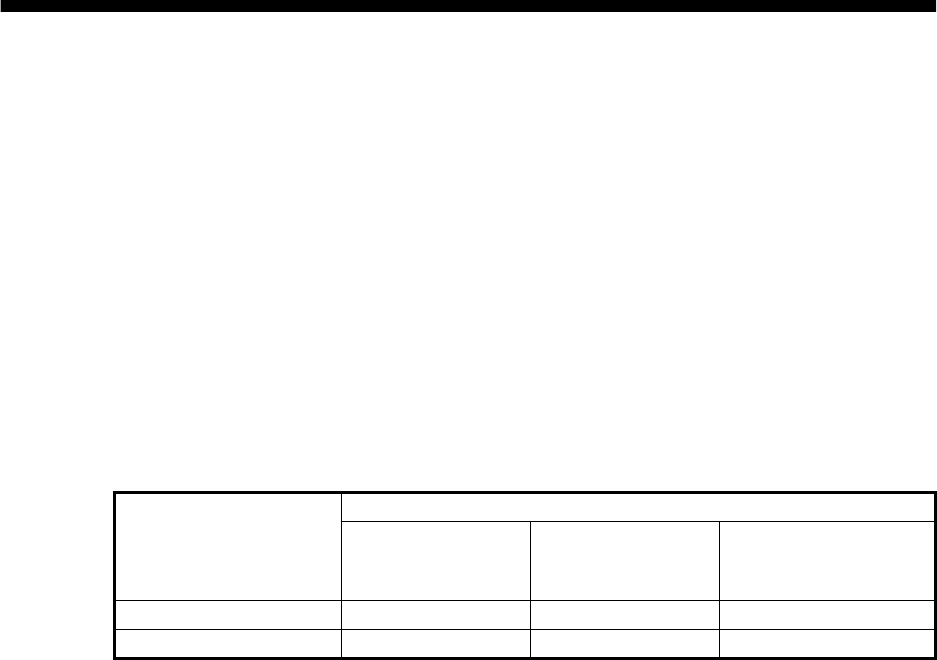
1-1
1. INSTALLATION
1.1 Before Beginning the Installation...
Please read the instructions below before beginning the installation.
• Do the installation following the instructions contained in this manual.
• Be sure to do the installation setup (tuning, timing, heading alignment, etc.) in chap-
ter 3 after installing the equipment.
• The cable names mentioned throughout this manual are JIS (Japan Industrial Stan-
dard) cables. If not available locally, see Appendix 1 for the equivalent cables.
• The control unit cannot be mounted in a console - it is designed to be mounted on
a desktop.
• See the table below for retrofit possibility. For use of the existing antenna cable of
FR-8125 or FR-8255, attachment of a connector (NH and VH) to the cable is nec-
essary. However, replacement of the cable is recommended.
• The antenna cable for the FAR-1513/FAR-1523 has connectors at both its ends. If
the cable is to be passed through a bulkhead, do not remove the connectors (to
make it easier to pass the cable through the bulkhead). Make an opening in the
bulkhead large enough to pass the connectors.
• Use only the specified power cable and fuse.
• Connect the DC power specification processor unit to the ship’s mains via a break-
er.
• Ground the AC power specification processor unit.
• If the processor unit is to be installed near where water or rain splash may occur,
install the optional waterproofing kit, which provides waterproofing standard IPX2.
Do not install the unit in an area where water or rain splash exceeds the conditions
of IPX2.
• Do not connect the radar to the ship’s onboard LAN.
• Connect the drain wires of external equipment to the specified locations in the pro-
cessor unit to prevent noise.
• Do not disassemble the equipment, to prevent electrical shock.
• Do not apply paint, anti-corrosive sealant or contact spray to coating or plastic parts
of the equipment. Those items contain organic solvents that can damage coating
and plastic parts, especially plastic connectors.
• In case of trouble consult with a FURUNO dealer.
• This series of radars are supplied with or without (BB type) a monitor. The configu-
ration is identical otherwise.
Retrofit possibility
FAR-1513/1523
FAR-1518/1528
(no Performance
Monitor)
FAR-1518/1528
(w/Performance
Monitor)
FR-8002 series Yes No No
FR-1500 MK3 series Yes Yes No
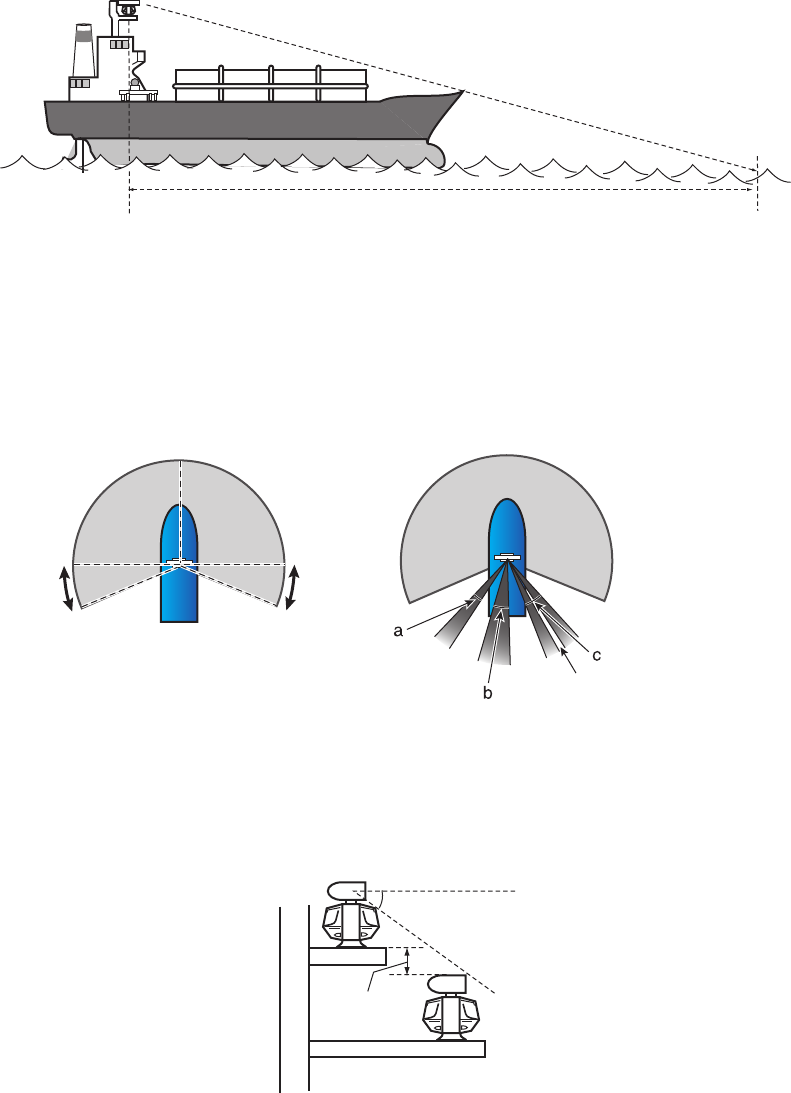
1. INSTALLATION
1-2
1.2 Antenna Unit Installation Considerations
• The antenna unit is generally installed either on top of the wheelhouse or on the ra-
dar mast, on a suitable platform. Locate the antenna unit in an elevated position to
permit maximum target visibility.
• A line of sight from the antenna unit to the bow of the ship must hit the surface of
the sea in not more than 500 m or twice the ship’s length, depending whichever val-
ue is smaller, for all load and trim conditions.
• Install the antenna unit so that any blind sectors caused by objects (mast, etc.) are
kept to a minimum. A blind sector must not exist in arc of the horizon from right
ahead to 22.5° aft of the beam to either side (see the figure below). Also, individual
blind sectors of more than 5° or the total arc of both blind sectors of more than 20°,
must not occur in the remaining arc (Figure 2). Note that any two blind sectors sep-
arated by 3° or less are regarded as one sector.
• Do not install the antenna where extreme winds may strike the port and starboard
sides of the antenna.
• Install the antenna unit away from interfering high-power energy sources and TX ra-
dio antennas.
• Keep the following distance and angle between another radar antenna.
• Keep the lower edge of the antenna unit above the safety rail by at least 500 mm.
less than 500 m or twice the ship's length
Figure 1 Figure 2
less than 3°
22.5°
22.5°
270° 90°
a, b, c: less than 5° respectively
a+b+c+: less than 20°
a, b, c: less than 5° respectively
a+b+c+: less than 20°
More than 20°
More than 1 m
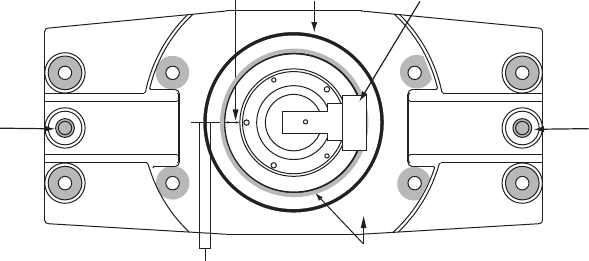
1. INSTALLATION
1-3
• No funnel, mast or derrick shall be within the vertical beamwidth of the antenna unit
in the bow direction, especially zero degree ±5° to prevent blind sectors and false
echoes on the radar picture.
• It is rarely possible to place the antenna unit where a completely clear view in all
directions is available. Therefore, determine the angular width and relative bearing
of any shadow sectors for their influence on the radar at the first opportunity after
fitting.
• Locate the antenna of an EPFS clear of the radar antenna to prevent interference
to the EPFS. A separation of more than two meters is recommended.
• A magnetic compass will be affected if the antenna unit is placed too close to the
compass. Observe the compass safe distances on page ii to prevent interference
to a magnetic compass.
• Do not paint the radiator aperture, to ensure proper emission of the radar waves.
• Ground the antenna unit with the supplied ground wire.
• Deposits and fumes from a funnel or other exhaust vent can affect the aerial perfor-
mance and hot gases may distort the radiator portion. Do not install the antenna unit
where the temperature is more than 55°.
• Leave sufficient space around the unit for maintenance and servicing. See the an-
tenna unit outline drawing for recommended maintenance space.
Note: For the IMO radar, please refer to IMO SN/Circ.271 "Guidelines for the installa-
tion of shipborne radar equipment".
1.3 How to Install the Antenna Unit for FAR-1518,
FAR-1528
1.3.1 How to fasten the radiator to the radiator bracket
The antenna unit consists of the antenna radiator and the antenna unit chassis, and
they are packed separately. Fasten the antenna radiator to the antenna unit chassis
as shown below.
1. For the XN20AF, XN24AF, Attach two guide pins to the underside of the antenna
radiator.
2. Remove the waveguide cap from the radiator bracket. The cap may be discarded.
3. Coat the waveguide flange with anticorrosive sealant as shown below.
Hole for
guide pin
5 mm Anticorrosive sealant
Waveguide cap
O-ring10 mm
Hole for
guide pin
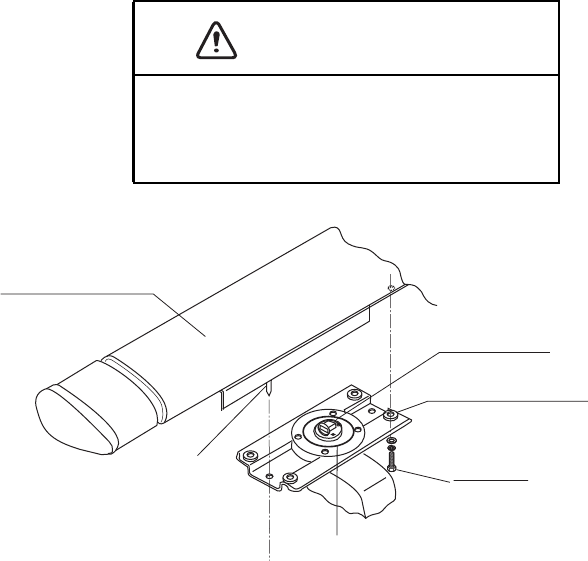
1. INSTALLATION
1-4
4. Coat fixing holes for the antenna radiator with anticorrosive sealant.
5. Grease the O-ring and set it to the O-ring groove of the radiator flange.
6. Set the antenna radiator to the radiator bracket.
7. Coat hex bolts M840 with anticorrosive sealant and use them to loosely fasten
the antenna radiator to the antenna unit chassis.
8. For the XN20AF, XN24AF, remove two guide pins (inserted at step 1), and then
tighten fixing bolts.
CAUTION
Be sure to remove the guide pins.
Injury may result if the guide pins loosen and
fall.
Antenna radiator
Waveguide
Radiator bracket
Hex bolt
XN12AF: M8×35
XN20AF, XN24AF: M8×40
O-ring
Guide pin
(XN20AF,
XN24AF)
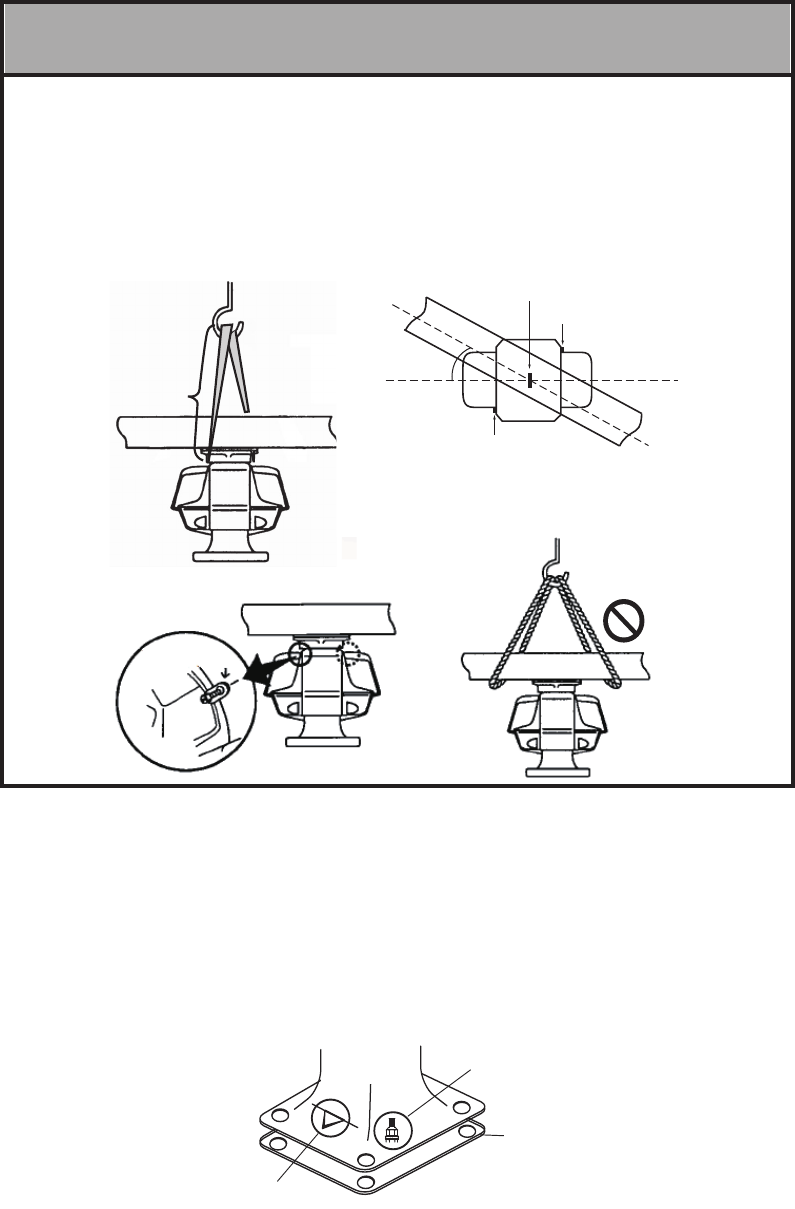
1. INSTALLATION
1-5
1.3.2 How to mount the antenna unit
The antenna unit may be assembled before hoisting it to the mounting platform. How-
ever, do not lift the antenna unit by the radiator. Always lift the unit by its housing.
When using a crane or hoist, use the hoist rings which should be fastened to the bolt
fixing covers of the antenna housing.
1. Construct a suitable mounting platform referring to the outline drawing at the end
of this manual.
2. Drill four mounting holes of 15 mm diameter and one cable entry hole of about 50
mm diameter in the mounting platform.
3. Lay the rubber mat (supplied) on the mounting platform.
4. Place the antenna unit on the rubber mat, orienting the unit so the bow mark on
its base faces the ship’s bow.
•
To hoist antenna unit aboard vessel, attach ropes to lifting fixtures and hoist
unit with crane.
• To remove load from radiator when hoisting, the length of the rope between
the radiator base and the hook must be at least 130 cm.
• To keep the rope away from the radiator, turn the radiator and chassis
approx. 30 degrees as shown below.
• BE SURE TO REMOVE THE HOIST RINGS AFTER HOISTING.
130 cm
Hook
Lifting fixture
Approx.
30 deg.
Approx.
30 deg.
Lifting fixture
(Top view)
Hoist
rings
Hoist
rings
NO!
How to Hoist the Antenna Unit
Ground
terminal
Anti-corrosion
rubber
Bow mark
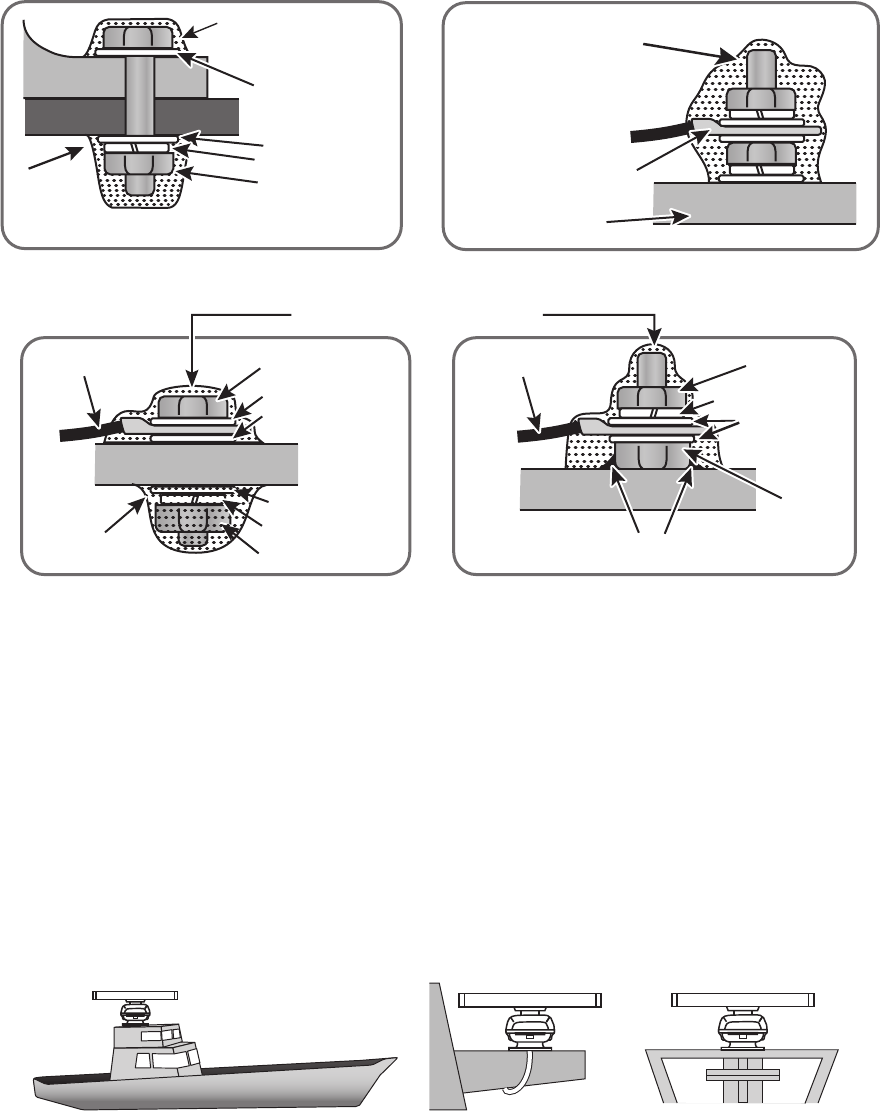
1. INSTALLATION
1-6
5. Fasten the antenna unit to the mounting platform with M1260 hex. bolts, nuts, flat
washers and seal washers.
6. Use hex. bolt (M625), nut (M6) and flat washers (M6) to establish the ground sys-
tem on the mounting platform as shown below. The location of the grounding point
should be within 340 mm of the ground terminal on the antenna unit. Connect the
ground wire (RW-4747, 340 mm, supplied) between the grounding point and the
ground terminal on the antenna unit. Coat the entire ground system with silicone
sealant (supplied).
7. Confirm that the hoist rings are removed.
1.4 How to Install the Antenna Unit for FAR-1513,
FAR-1523
1.4.1 Installation guidelines
Below are common mounting locations. See the guidelines in section 1.1 for siting
considerations.
Hex bolt
OR
Ground wire
Welding
Hex nut
Grounding
Hex
bolt
Flat washer
Hex nut
Spring washer
Flat washer Flat
washer
Spring washer
Ground wire
Coat with marine sealant.
Flat washer
Coat with
marine
sealant.
Seal washer
(Torque: 49 N•m)
Flat washer
Spring washer
Fasten ground wire
then coat with marine
sealant.
Ground wire
Antenna chassis
Nut
Fixing bolt Antenna base
Coat with marine
sealant.
Coat with
marine
sealant.
(a) Bridge (b) Common mast (c) Radar mast
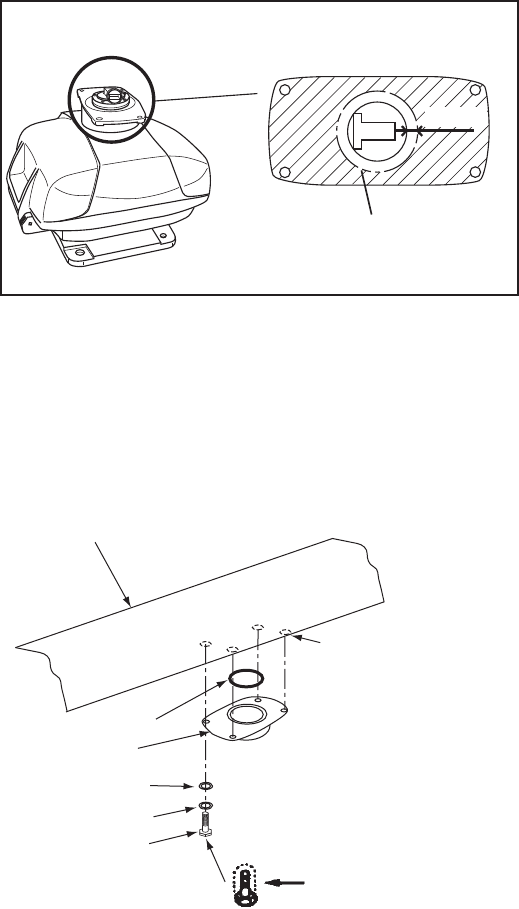
1. INSTALLATION
1-7
1.4.2 How to fasten the radiator to the radiator bracket
Make five holes in the platform - four holes to fasten the antenna unit and one hole for
the signal cable, referring to the outline drawing at the back of this manual for the di-
mensions.
See the packing list at the back of this manual for the installation materials.
1. Remove the radiator cap from the radiator bracket.
2. Apply marine sealant to the surface of the antenna radiator and the radiator brack-
et. See the figure below for the location.
3. Apply the marine sealant to the threads in the four holes on the antenna radiator.
4. Apply the grease to the O-ring and set the O-ring to the radiator bracket.
5. Set the antenna radiator on the radiator bracket.
6. Fasten the antenna radiator to the radiator bracket with the radiator bolts, flat
washers and spring washers. Apply the marine sealant to the radiator bolts (4
pieces).
RADIATOR BRACKET
(top view)
Coat hatched area with
marine sealant.
10mm
Flat washer
Spring washer
Hex head bolt
(M8×30)
Radiator bracket
Apply marine sealant
to bolts.
Antenna
radiator
O-ring
Apply marine sealant
to threaded holes.
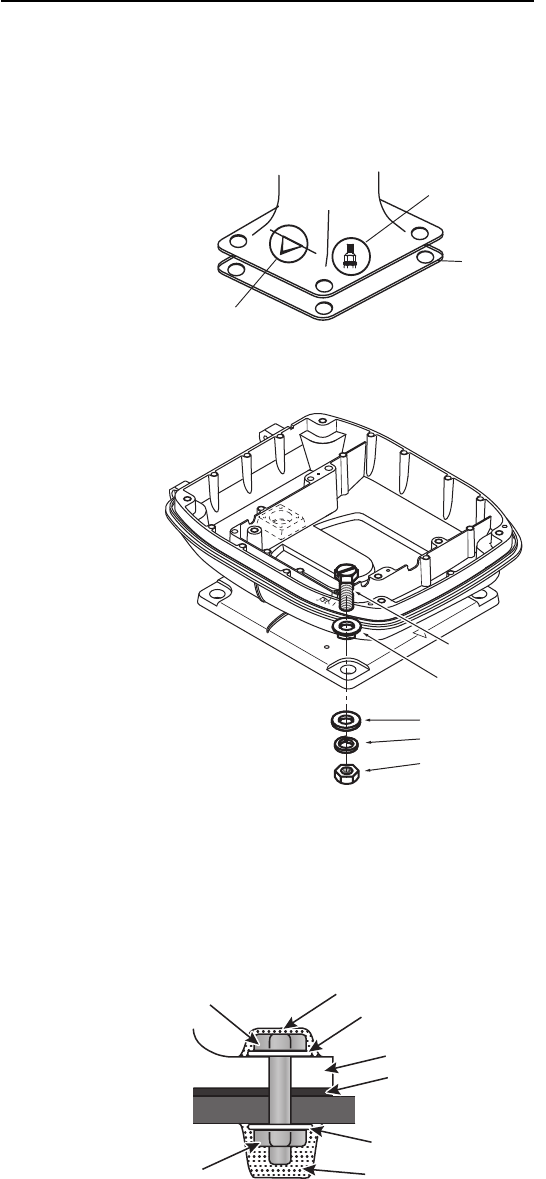
1. INSTALLATION
1-8
1.4.3 How to mount the antenna unit
The antenna unit can be mounted using the holes on the outside or inside of the chas-
sis. Choose the mounting method and follow the applicable procedure below.
Mounting using the outside holes on the chassis
1. Put the rubber mat (supplied) on the mounting location.
2. Referring to paragraph 1.3.2, hoist the antenna unit to the mounting location.
3. Place the antenna unit on the anti-corrosion rubber, orienting the unit so the bow
mark on its base faces the ship’s bow.
4. Set four hex head bolts (M1260, supplied) and seal washers (supplied) from the
top of the antenna housing, as shown below.
5. Set the flat washers (M12, supplied), spring washers (supplied) and nuts (sup-
plied) to the hex head bolts. Tighten by turning the nuts. Do not tighten by turning
the hex head bolts, to prevent damage to the seal washers.
6. Apply anticorrosive sealant to the flat washers, spring washers, nuts and visible
parts of bolts.
7. Prepare the ground point on the mounting platform. Use an M625 bolt, nut and
flat washer (supplied). The ground point must be within 300 mm from the ground
terminal on the antenna unit.
Ground
terminal
Anti-corrosion
rubber
Bow mark
Hex bolt
Seal washer
Flat washer
Spring washer
Nut
Seal washer
Antenna chassis
Anti-corrosion
rubber
Seal washer
Marine sealant
Marine sealant
Bolt
Nut
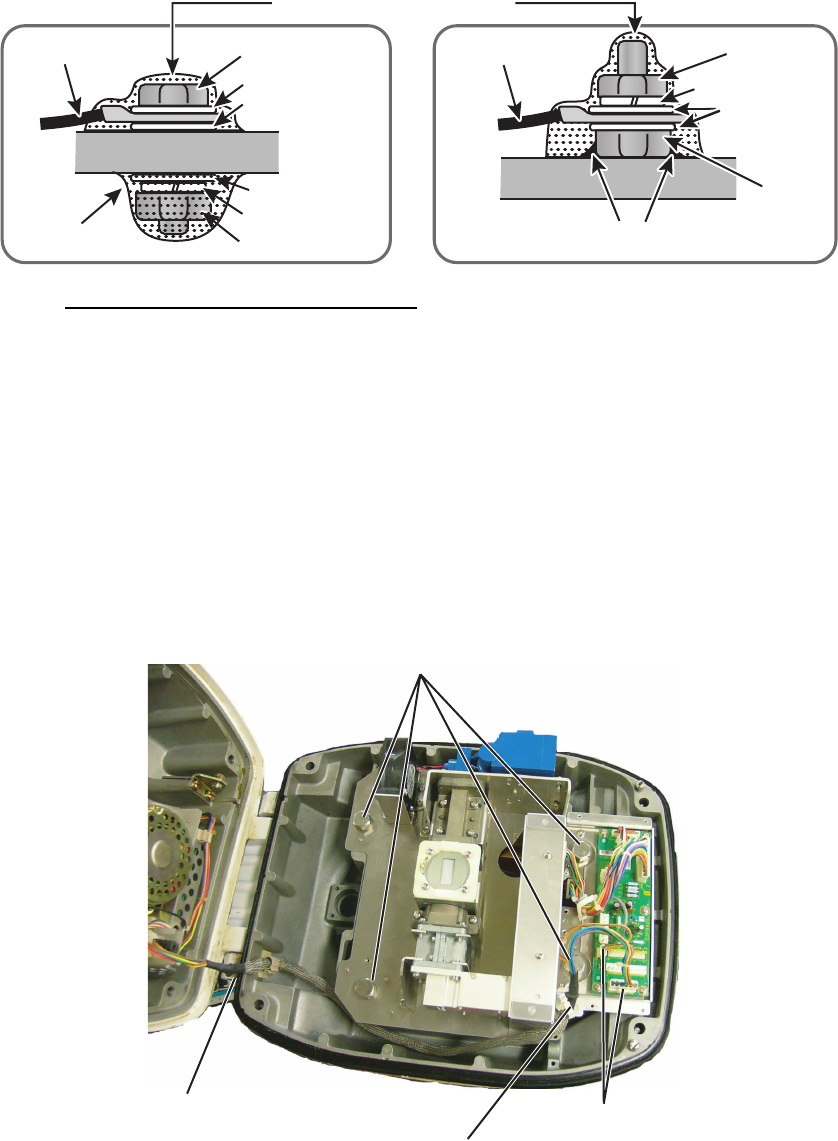
1. INSTALLATION
1-9
8. Fasten the ground wire (RW-4747, 340 mm, supplied) between the ground termi-
nal and the ground point.
9. Apply marine sealant to the ground terminal and ground point as shown below.
Mounting using the inside holes
This method requires removal of the RF unit in the antenna unit to access inside fixing
holes. Use hex head bolts, flat washers, spring washers and nuts (local supply) to
mount the antenna unit, confirming length of bolts.
1. Unfasten four antenna bolts on the cover to open the antenna unit.
2. Unfasten four screws on the RTB cover to remove it.
3. Unplug connector J827 and J834 on the RTB board.
4. Separate upper chassis from lower chassis by removing two hex head bolts
(M825).
5. Remove RF unit by unfastening four hex head bolts.
6. Lay the corrosion-proof rubber mat (supplied) on the mounting platform.
Hex bolt
OR
Ground wire
Welding
Hex nut
Hex
bolt
Flat washer
Hex nut
Spring washer
Flat washer Flat
washer
Spring washer
Ground wire
Coat with marine sealant.
Flat washer
Coat with
marine
sealant.
Hex. bolt(M10×20)
Hex. bolt(M8×25) J827, J834
Remove from cable clamp
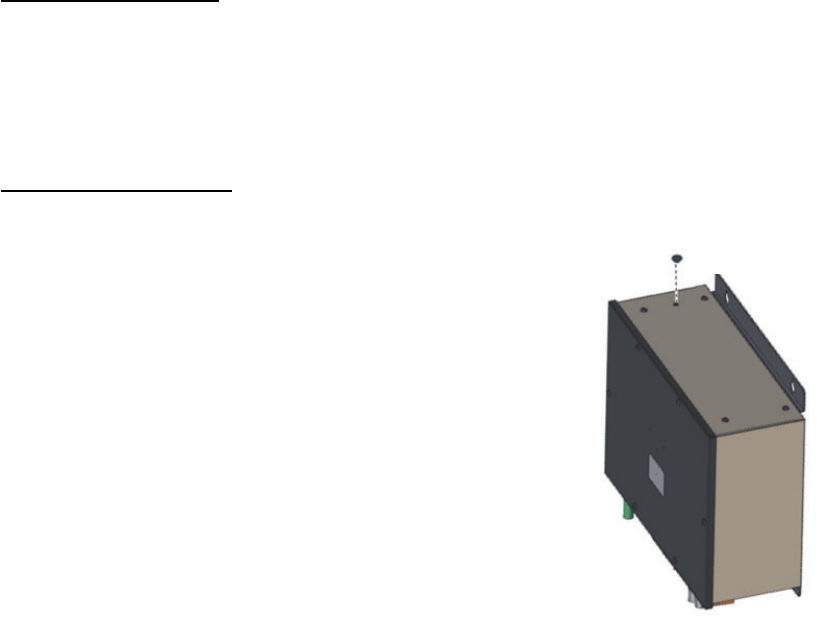
1. INSTALLATION
1-10
7. Fasten the lower chassis to the mounting platform with hex head bolts, spring
washers, flat washers and nuts (local supply), and then coat flat washers, nuts
and exposed parts of bolts with marine sealant. Cut a slit in the rubber bushing
and insert bolt into the bushing. Do not use seal washers.
8. Reassemble the RF unit, cover and chassis.
9. Set four knob caps (supplied) into outside fixing holes.
1.5 Processor Unit
1.5.1 Mounting considerations
The processor unit can be mounted on a desktop or bulkhead. When selecting a
mounting location, keep in mind the following points.
• Locate the unit out of direct sunlight and away from heat sources because of heat
that can build up inside the cabinet.
• Locate the equipment away from places subject to water splash and rain.
• Select a mounting location considering the length of the cables connected.
• Leave sufficient space on the sides and rear of the unit to facilitate maintenance.
(See the outline drawing at the back of this manual.)
• A magnetic compass will be affected if placed too close to the processor unit. Ob-
serve the compass safe distances shown on page ii to prevent interference to a
magnetic compass.
1.5.2 How to mount the processor unit
Desktop installation
Fasten the unit with four bolts (M5, supplied) or self-tapping screws (520, local sup-
ply).
Note: If the installation must meet the waterproofing standard IPX2, use the processor
unit IPX2 kit. See paragraph 2.4.4 for details.
Bulkhead installation
Mark locations for four self-tapping screws if screws will be
used. Insert four M5 bolts (or self-tapping screws), leaving
approx. 5 mm of the bolts (screws) exposed. Hang the pro-
cessor unit on the four bolts (screws) inserted at step 2.
Tighten all bolts (screws).
Note: If the installation must meet the waterproofing stan-
dard IPX2, set the blind seal supplied with the processor unit
installation materials (CP03-36501) to the unit as shown in
the right figure.
Blind seal
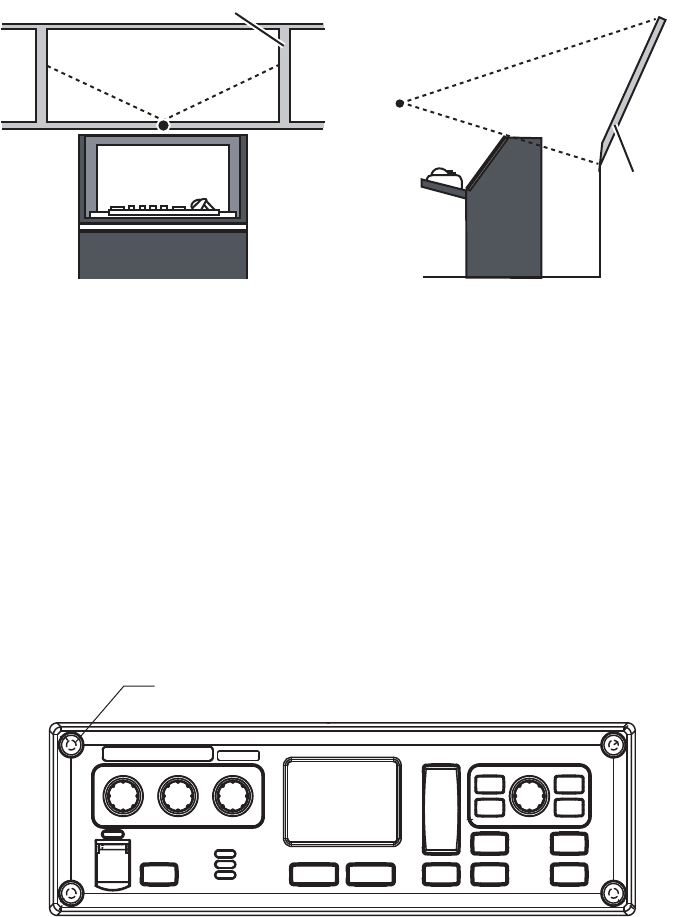
1. INSTALLATION
1-11
1.6 Display Unit
See the operator's manual for MU-150HD (OMC-44560) for the installation procedure.
Keep in mind the following points when selecting a location.
• Locate the display unit where no framing is installed immediately forward of the dis-
play unit.
• Locate the display unit where it is easy to view the display in all ambient lighting con-
ditions.
1.7 Control Unit
The control unit is designed to be fixed to a desktop. Install the control unit within five
meters from the processor unit since the length of the cable connecting them is five
meters.
1. Drill four mounting holes of 5 mm diameter referring to the outline drawing at the
back of this manual.
2. Fix the control unit with four self-tapping screws (4, local supply) from the top of
the control unit. Make the screws are long enough.
3. Attach four cosmetic caps to the fixing holes on the control unit.
Note: A plastic bag is attached to the end of the USB cable at the factory to fulfill the
requirements for waterproofing standard IPX2. If the waterproofing standard is re-
quired, do not remove the plastic bag.
Bridge
window
Viewing point
Viewing point
Viewing point
Viewing point
Bridge window
Fixing hole
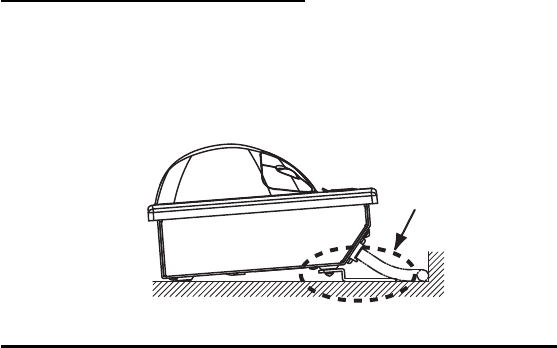
1. INSTALLATION
1-12
1.8 Trackball Control Unit (option)
How to mount the unit tilted
Use the desk fixing plate to mount the unit tilted. Fasten the desk fixing plate to the
bottom of the control unit. Fasten the control unit with self-tapping screws (local sup-
ply).
How to mount the unit flush with mounting surface
Drill four mounting holes of 5 mm in diameter referring to the outline drawing at the
back of this manual. Fasten the control unit with four M4 screws (local supply) from
the underside of the desktop.
Desk fixing plate
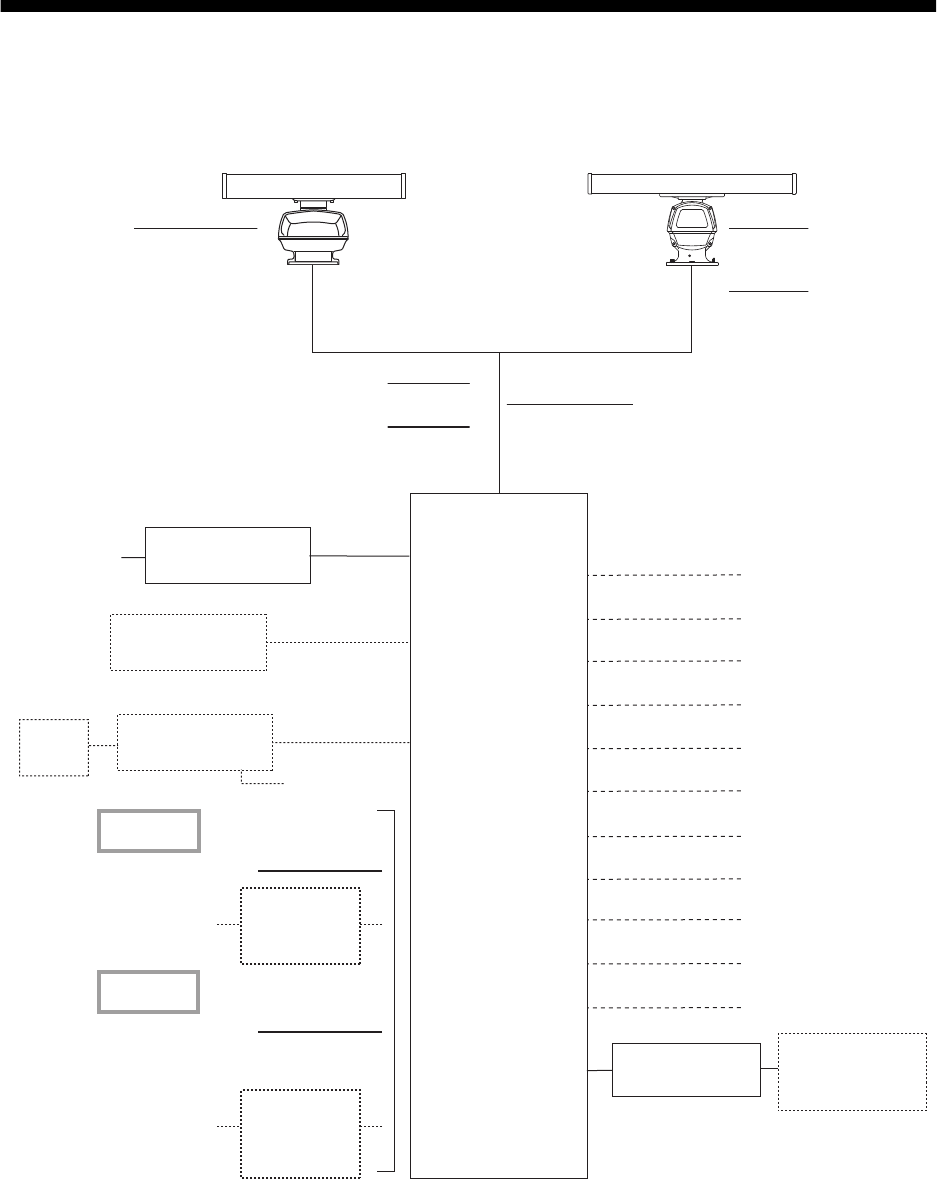
2-1
2. WIRING
2.1 Wiring Outline
ANTENNA UNIT
100/110/115
200/220/230
1ø, 50/60 Hz
PROCESSOR UNIT
RPU-024
12-24 VDC DISPLAY UNIT
MU-150HD(-CV15)
Analog RBG
Monitor
SWITCHING HUB
HUB-100 100-230 VAC
1ø, 50/60 Hz
DC Spec.
24 VDC
Rectifier
RU-1746-B
RU-3424
440 VAC
1ø, 50/60 Hz
AC Spec.
Stepdown
Transformer
Unit
RU-1803
100/110/115
200/220/230
1ø, 50/60 Hz
FAR-1518
XN12AF
XN20AF
FAR-1528
XN20AF
XN24AF
DVI-D/D
S-LINK
(5/10 m)
3COX-2P-6C
(5/10 m)
FR-FTPC-CY
10/20/30 m)
MOD-Z072
(2/5/10 m)
Radar
ECDIS
FAR-1518/1528
RW-0030
(15/20/30 m)
CONTROL UNIT
RCU-028
TRACKBALL
CONTROL UNIT
RCU-030
AD-100
Heading sensor
AIS transponder
GPs navigator
Doppler log
AMS (serial)
ECDIS
AMS (contact)
Master
Sub display 1
Sub display 2
TTYCSLA-4
TTYCSLA-1Q
TTYCSLA-4
TTYCSLA-1
TTYCSLA-1
TTYCSLA-4
TTYCSLA-4
TTYCSLA-7
RW-4864
(1/5/10 m)
RW-4864
(1/5/10 m)
DPYC-6
DPYC-2.5
FAR-1513/1523
XN12A
XN13A
ANTENNA UNIT
OR
FAR-1513
RW-00024
FAR-1523
RW-00025
(15/20/30 m)
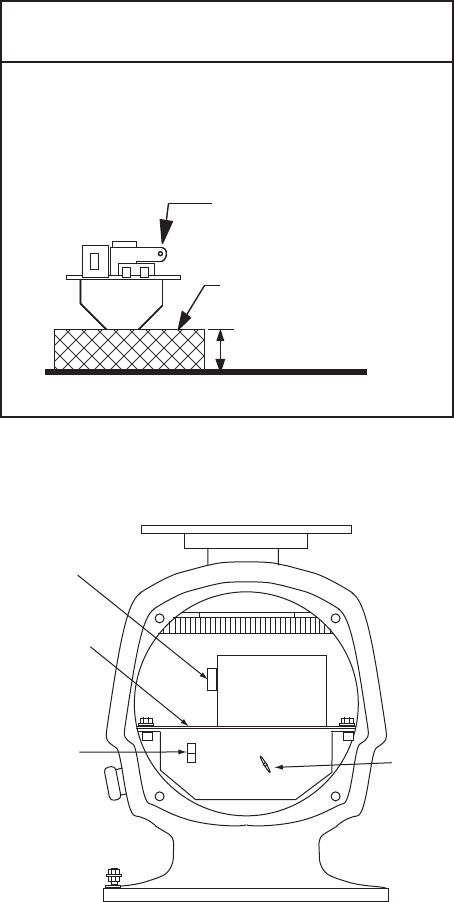
2. WIRING
2-2
2.2 How to Connect the Signal Cable for FAR-1518,
FAR-1528
In order to minimize the chance of picking up electrical interference, avoid where pos-
sible routing the signal cable near other onboard electrical equipment. Also, avoid run-
ning the cable in parallel with power cables.
1. Open the antenna cover.
2. Disconnect plugs P821, P822, P801 and P802.
3. Unfasten the transceiver module (two bolts). Remove the transceiver module.
4. Unfasten four fixing bolts on the cable gland at the base of the antenna unit. Re-
move clamping ring, rubber gasket and washers.
5. Pass the signal cable through the cable entry hole in the antenna unit mounting
platform. Trim the cable to 500 mm length from the cable gland.
Transceiver module
(magnetron inside)
Height more
than 5 cm
Non-ferrous block
The magnetron in the transceiver module will de-
magnetize if it contacts ferrous material. When
dismounting the transceiver module, lay it on its
side or on top of non-ferrous material as shown
below.
NOTICE
J801 and J802
(on pcb 03P9506)
J822
(on pcb 03P9487)
Ground terminal
J821
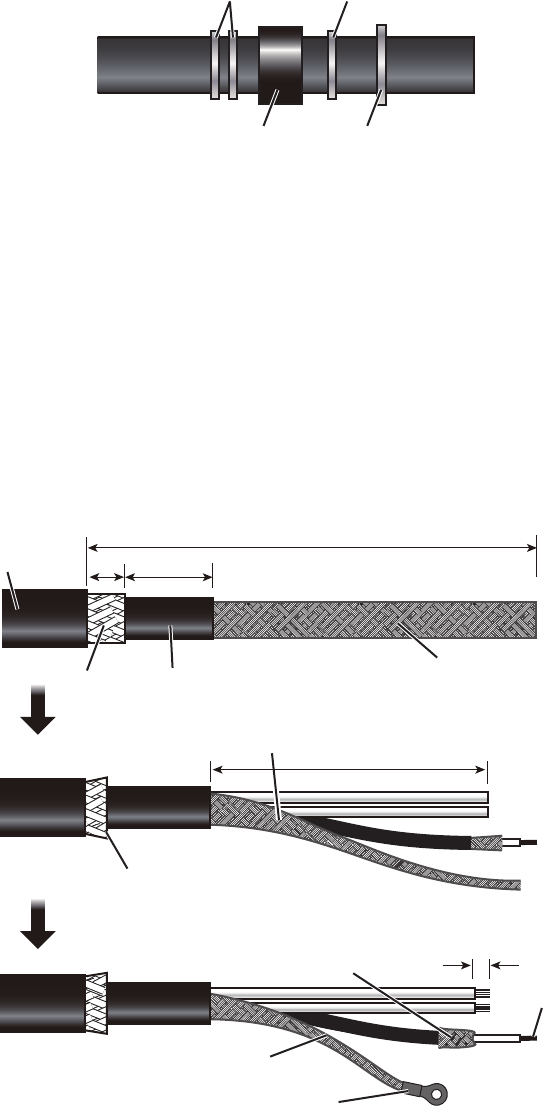
2. WIRING
2-3
6. Slide two washers, rubber gasket, washer and clamping ring onto the cable in that
order.
7. Fabricate the signal cable as shown below.
1) Remove the vinyl sheaths 500 mm.
2) Unravel the outer shield to expose the cores in the outer layer. Then, expose
the cores in the inner layer. Label all inner cores to aid in identification.
3) Trim each core (except coaxial wire) considering its location on the terminal
board.
4) Trim the inner and outer shields leaving 510 mm each. Twist shields together
and attach crimp-on lug FV5.5-4 (blue, 4).
5) Remove insulation of each core approx. 8 mm.
6) Fabricate the coaxial cable.
Flat washer
Gasket Clamping ring
Flat washer
500
500
20
20
Vinyl sheath
Armor Shield
Attach the crimp-on lug to the core.
Inner/Outer shield
Fold back shield.
Attach the TNC
connector (local
supply) here.
Core
Coaxial
cable
10
10
8
Vinyl sheath (inner)
Trim armor.
Expose the cables then twist shield.
Expose the cables then twist shield.
430
430
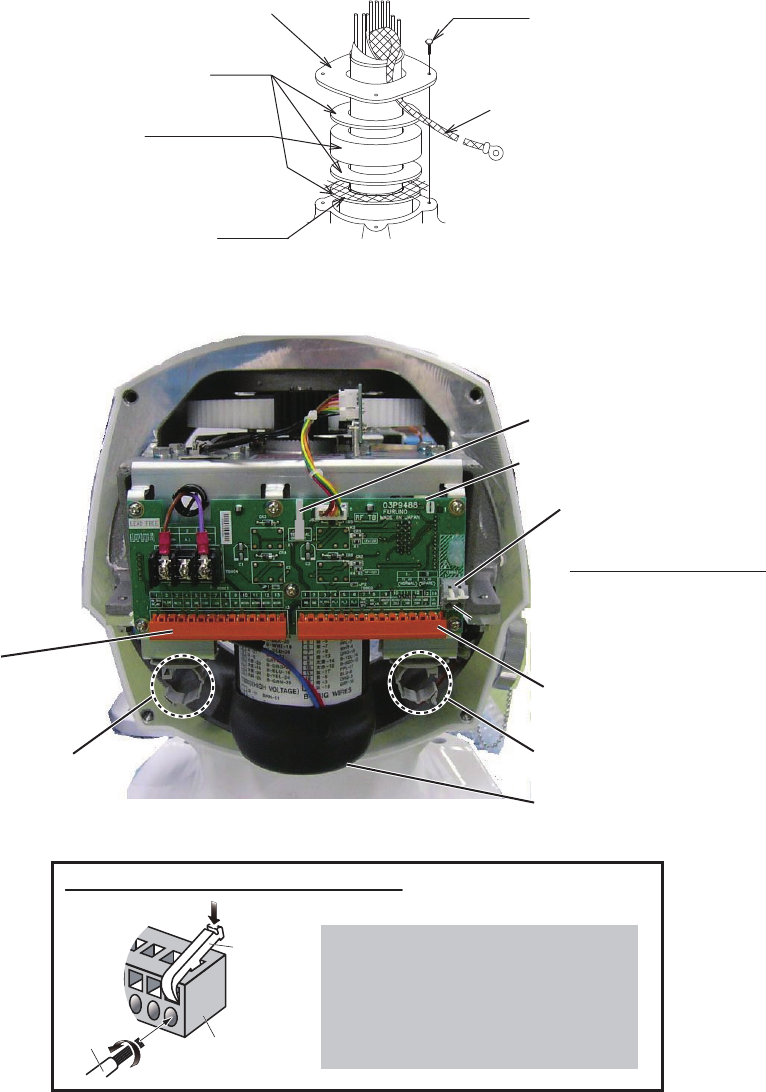
2. WIRING
2-4
8. Pass the shield between the clamping ring and the washer as shown below. Fas-
ten the clamping ring with the screws.
9. Connect the signal cable to the terminal board TB801, TB802 and TB803 on the
RF board (03P9488), referring to the interconnection diagram.
Clamping ring
Washer
Rubber gasket
Bolt
4-M4×16
Shield
Armor
Terminal opener
RF board (03P9488A)
TB803
(High-Voltage line)
TB802
(WAGO connector)
Cable clamp
Motor
TB801
(WAGO connector)
Cable clamp
Core
entrance
Core
entrance
How to insert the core
1. Push lever.
2. Insert core.
3. Release lever.
Wire
How to connect wires to WAGO connector
Press downward.
Terminal
opener
WAGO
connector
Twist
<Procedure>
1. Twist the cores.
2. Press the terminal opener downward.
3. Insert the wire to hole.
4. Remove the terminal opener.
5. Pull the wire to confirm that it is secure.